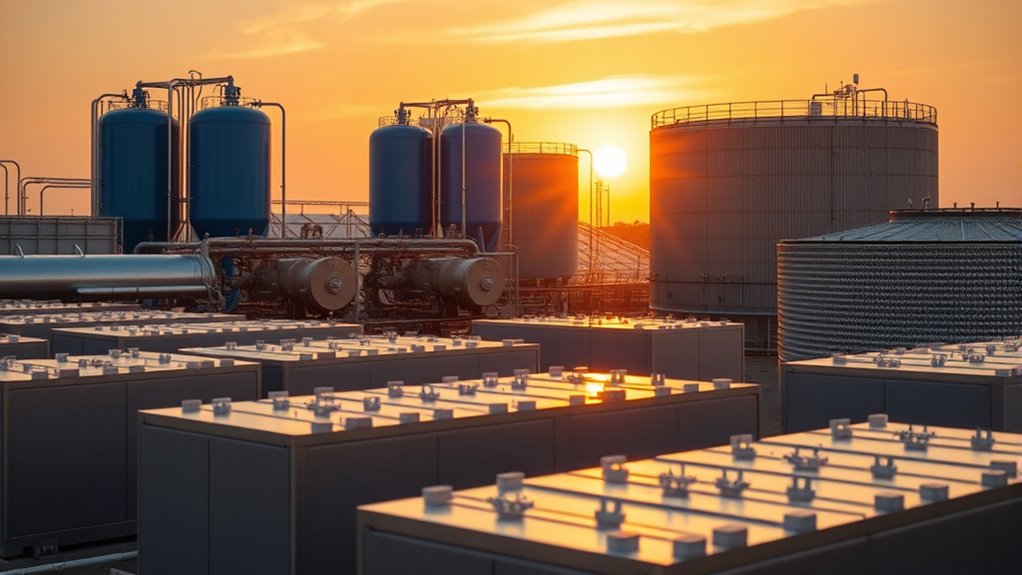Renewable energy storage is essential for keeping your power supply reliable and efficient. Batteries provide quick, versatile energy storage for short and long-term needs, with high efficiencies. Hydrogen transforms excess electricity into fuel for long-term storage and future use, while thermal systems store heat for electricity or heating applications. By understanding these methods, you can better appreciate how they help balance the grid and maximize renewable energy use—keep exploring to discover more about these innovative solutions.
Key Takeaways
- Batteries offer quick, efficient, short- and long-term energy storage with high round-trip efficiencies for diverse applications.
- Hydrogen storage converts excess renewable energy into hydrogen, suitable for long-term and large-scale energy balancing.
- Thermal energy storage captures heat from excess energy, enabling direct heating or electricity generation with decoupled supply and demand.
- Combining these methods enhances grid stability, reliability, and flexibility in integrating renewable energy sources.
- Technological advancements are improving efficiency, cost-effectiveness, and scalability across batteries, hydrogen, and thermal storage systems.

Have you ever wondered how renewable energy sources like solar and wind can provide power around the clock? The answer lies in effective renewable energy storage systems. These systems enable you to store excess energy generated during peak times and release it when demand is high or generation drops, guaranteeing a steady power supply. When it comes to integrating renewables into the grid, storage plays a vital role. Grid integration becomes smoother because storage solutions help balance supply and demand, reducing the risk of blackouts and easing the strain on traditional power plants. If you’re considering implementing such systems, understanding storage efficiency is essential—it’s about how well your chosen method can store and deliver energy without losing too much along the way.
Effective renewable energy storage ensures a reliable, steady power supply by balancing supply and demand around the clock.
Batteries are perhaps the most well-known form of renewable energy storage. They are highly versatile, capable of quick response times, and are especially effective for balancing grid integration. When solar panels or wind turbines generate excess power, batteries can absorb this energy efficiently, storing it for later use. The key to maximizing this process is high storage efficiency, which determines how much energy you get out compared to what you put in. Modern lithium-ion batteries, for example, can achieve efficiencies above 90%, making them a reliable option for both short-term and long-term storage needs. They’re scalable, with applications ranging from small residential setups to large utility-scale projects. This flexibility helps you create a more resilient grid, especially in areas with intermittent renewable generation.
Hydrogen offers a different approach. Instead of storing electricity directly, you convert excess renewable energy into hydrogen through electrolysis. This hydrogen can then be stored in tanks or underground caverns, providing a dense and long-term energy reservoir. When needed, the hydrogen can be converted back into electricity using fuel cells or burned for heat. This method is particularly useful for balancing grid integration over longer periods and can support sectors difficult to electrify directly. However, the efficiency of hydrogen storage depends on the electrolysis and fuel cell technologies used, with current systems achieving around 60-70% overall efficiency. Advances in these areas are improving storage efficiency, making hydrogen an increasingly practical renewable energy storage option.
Thermal energy storage is another effective method, especially for heating and cooling applications. It involves storing excess energy as heat in materials like molten salts or other phase-change substances. During periods of high demand, this stored thermal energy can be converted back into electricity or used directly for heating. While thermal storage isn’t as flexible as batteries for instant power delivery, it excels at decoupling energy production from consumption, helping to stabilize the grid. Its storage efficiency hinges on minimizing heat losses over time. With ongoing technological improvements, thermal storage is becoming more cost-effective and efficient, providing a reliable way to integrate renewable energy into existing infrastructure. Additionally, ongoing research into advanced storage materials is helping to further improve overall system performance.
In all these options, understanding the nuances of grid integration and aiming for high storage efficiency guarantees you make the most of renewable energy. This way, you can enjoy a cleaner, more reliable power system that meets your needs around the clock.
Frequently Asked Questions
What Is the Environmental Impact of Different Energy Storage Methods?
When considering energy storage methods, you should assess their environmental footprint and potential ecosystem disruption. Batteries may cause pollution and resource depletion, while hydrogen production can lead to emissions if not renewable. Thermal storage often requires significant land and energy use, impacting ecosystems. You need to weigh these impacts carefully, aiming for options that minimize harm to the environment and preserve ecosystems while supporting your renewable energy goals.
How Long Can Each Storage Technology Reliably Store Energy?
Imagine your energy storage lasting forever—well, not quite, but close! Batteries typically offer a lifespan of 5 to 15 years, depending on usage, while hydrogen can store energy for months without losing power. Thermal storage can hold energy for days or even weeks. You can rely on batteries for quick, frequent use, and hydrogen or thermal for longer-term needs, making each method fit different energy demands.
What Are the Costs Associated With Large-Scale Energy Storage?
When you compare costs for large-scale energy storage, you’ll find significant differences. The cost comparison depends on the technology and capacity, with batteries often being more expensive upfront but cheaper over time. Infrastructure requirements vary; batteries need minimal space, while hydrogen needs extensive facilities. You should consider installation, maintenance, and operational expenses to determine the most cost-effective solution for your energy needs.
How Do Storage Options Vary by Geographic Region?
You’ll find that storage options vary markedly by geographic suitability and regional deployment. In sunny areas, solar thermal storage is effective, while windy regions benefit from large-scale batteries. Hydrogen storage suits regions with abundant water resources, and thermal methods are ideal where seasonal storage is needed. Your choice depends on regional climate, infrastructure, and energy demands, making it essential to tailor energy storage solutions to the specific geographic context.
What Advancements Are Anticipated in Storage Technology Efficiency?
You’ll see advancements in storage technology efficiency through innovative materials that boost energy density and durability. Researchers are also focusing on system integration, making storage solutions more seamless with renewable sources. These improvements will likely lead to faster charging, longer-lasting systems, and reduced costs. As a result, energy storage becomes more reliable and scalable, helping you maximize renewable energy use and accelerate the shift to cleaner power sources.
Conclusion
Think of renewable energy storage as the bridge to a sustainable future, just like a sturdy bridge connects two places. Batteries, hydrogen, and thermal storage work together to keep your power reliable and clean, even when the sun isn’t shining or the wind isn’t blowing. By embracing these technologies, you’re helping to build a greener world—one where energy flows smoothly, like a well-oiled machine. Together, we can light the way toward a brighter, more sustainable tomorrow.









